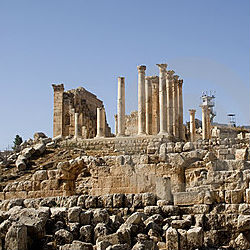
Jerash became a member of the Decapolis, a federation of Greek cities, in the third century during the Hellenistic era. It was then known as Gerasa.
Jerash enjoyed semi-autonomous status after its conquering by Pompeii and held considerable prestige as part of the Roman province of Syria, during which it prospered from its position on the incense and spice trade route.
Jerash lost its autonomy under Emperor Trajan, but his annexation of Petra in 106 AD brought the city even more wealth. Several temples were built during this period, including the Temple of Artemis and Temple of Zeus.
Jerash was reborn as a Christian city under the Byzantines after a decline in the third century. It flourished especially during the reign of Justinian, during which at least seven churches were added to the city.
The last church was built in 611, and Jerash went downhill from there. The city was invaded by Persians in 614, captured by Muslims in 635 and badly damaged by several earthquakes in the 8th century.
By the time the Crusaders arrived in the 12th century, Jerash had been uninhabited for some time. Excavations of Jerash began in the 1920s and are ongoing today.
A large and fascinating archaeological site, visitors enter on the south side through Hadrian's Arch. Nearby is the Hippodrome, where chariot races and sporting events were held. A little way down the track is the South Gate, part of the 4th-century AD city wall.
The Temple of Zeus overlooks the spacious Oval Plaza. Surrounded by a colonnade of 1st-century Ionic columns, it had two altars in the middle that were replaced with a fountain in the 7th century AD. A central column was recently erected to carry the Jerash Festival flame.
From the Oval Plaza, a staircase leads up to the sacred precinct of the Temple of Zeus. Another staircase led to the temple itself, which is surrounded by high Corinthian columns.
Source: Catholic Online [June 09, 2011]